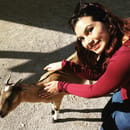I’m biracial: 50 percent Mexican on my dad’s side and 50 percent “European Mutt,” as my mom calls it. My non-Mexican side is composed of one percent and two percent of everything, like Dutch, German, Irish and so many more. Mexican is the most predominant, which is why I identify as such. I don’t look the Mexican part at all, and I never learned Spanish growing up, but I have always loved being Mexican. For Heritage Day in middle school, I wore this beautiful vestido folklorico that I got to pick out with my dad at the Mercado de México in Coyoacán. It was red, white and green with ruffles that came down on my shoulders and I felt beautiful. Mexican was a beautiful color to me, it was good food (carnitas, pork pozole, tamales, pollo con mole and chilaquiles with green sauce—you know what I’m talking about) and it was huge parties with my family, dancing to songs I didn’t understand but made me want to move. That was what being Mexican was to me, beauty; and it still is, but during high school it didn’t feel that way.
I started noticing weird things like: why does dad always get stopped at airport security for “random checks?” Why were the cops called on mi primo Jacobo for playing with a toy gun in the street? What does it mean when people laugh and say “there’s the Latina” when I got angry or had an outburst? Why do people like to tell me I’m not really biracial? My dad said that it was because there were people in this world that did not like or feared people who did not look like them. He said that sometimes they did mean things to people who looked like him or mis primos. These people were called racists.
I thought, “Well why did he specify himself and mis primos? Why didn’t he include me? I’m Mexican too.” It took me a while to figure this one out. My dad, a very fair-skinned Mexican, and my very white mom had made three biracial babies that people assumed were just white.
Then I got it. He didn’t include me because we did not experience the same racism, and we never would. When the former President of the United States announced to the people that Mexicans were “thugs, rapists and drug dealers,” he wasn’t talking about me or my brothers—he was talking about my dad, about mis abuelos and mis primos. He was talking about people that looked brown—and that did not include me. I was invisible to the racism. My parents never had to have the “what to do if you’re pulled over” conversation with me. Grocery store clerks did not follow me around their stores to watch if I was stealing, and cops never assumed I was suspicious because my hood was up. Did that make me less Mexican?
As a kid, you don’t expect or understand racism. It is hard to fathom that people hate you or your family because you look a certain way or because you are something. As you get older, you gain an understanding of it, but it never prepares you for the first time you experience it. It definitely never prepares you for when people you’re close to show racist tendencies or bias.
——————
Undeniably, I was very privileged growing up. My white skin let me glide by while mis primos with brown skin found obstacles they had overcome that I didn’t. My dad sheltered me from much of the racism that the Mexican community faces. He didn’t want the negative experiences he had to go through for me, and while I appreciate his love, I was not prepared for what high school would bring. After attending a primarily white middle school and elementary school, with only one other BIPOC student, I was thrown into the sea of high school. Although, again a primarily white institution, there was more diversity among the students, it seemed like everyone congregated towards people who looked like them. I was so intimidated by the other Mexican students; they were so much better at being Mexican than I was. They spoke fluent Spanish; they loved foods I had never heard of and they called me gringa. I’ve struggled with the fear of being invalidated by someone who is “more Mexican” than I am, or who spoke better Spanish my entire life, so for a long time I avoided identifying myself as Mexican.
Eventually, I realized it was never other Mexican students that made me feel invalidated. They encouraged me to learn more Spanish; they played me songs I didn’t know, and they showed me foods I had never tried. It was always white people. White people loved to remind me I don’t speak Spanish, that I didn’t “act” Mexican and that my skin is white. The Mexican students never told me I wasn’t Mexican, instead they were excited to help me learn about our culture. When Trump was elected president in 2016, my white friends joked that I’d be deported. Some of them even told me to watch out for I.C.E. if I didn’t want my dad to be taken away. It almost felt like a threat, even though my dad was born in America. I saw racist bias and tendencies more and more from my white friends. My friends were told that going near 18th or 26th street (among other parts of Chicago) was too dangerous to visit or drive through, but my family lived there and the best restaurants in Chicago were there. Did they find my family scary? Even in our own suburbs, my friends were told to be careful in certain parts of Brookfield, the same parts that mis primos lived in. Why did it always seem that the places “to stay away from,” Black or brown communities primarily inhabited?
Many talks with my dad and aunts and being at college gave me perspective. My mistake was thinking that because I had learned so much about my own racial identity and the forms of racism my freshman year of college, that my old friends would also understand. Coming back after my first year of college I was catching up with my (white) friends about friends, sororities and guys we had met, and I showed them a picture of a boy that I thought was so cute, and he happened to be a person of color. Then, they told me how all of their parents had said they were never allowed to date or marry a man that was not white and before I even had a chance to address the overwhelming amount of racism packed into that sentence, they all immediately started with “but my parents aren’t racist.” Which, if you need to use that phrase, then yeah, they probably are racist (in this case undeniably so). First of all, I was in shock. How could they be my friends and think that that was okay? They said it was because their parents did not want them to be in a biracial marriage. Their parents understood the hardships of biracial couples, and they didn’t want them to have to experience that. How could their parents, who were all white, understand what it was like for a biracial couple? When I reminded them that I’m biracial, they said, “Yeah but not really.” How could I still not be biracial? Did I miss the sign-up sheet? I then reminded them that my parents were a biracial couple, they said, “Yeah but they don’t count.” Why don’t they count? Did they not count because they did not actively reinforce their bias of biracial couples?
I only count as Mexican to white people and primarily white institutions when it comes to diversity statistics. I count as the “Mexican friend.” I count as part of the Hispanic/Latino populations at any institute or organization I attend, but how is that fair? How is it fair that I glide past racism but get to apply for scholarships meant for a population that endures racism and its effects? Institutions want me to check Hispanic or Latino on their forms to boost their diversity numbers and people always tell me not to forget that box if I’m applying to something. My dad tells me that it is okay for me to use these resources meant for Hispanic and Latino populations but I’m still not sure.
——————
After all this contemplating, I wish I could tell you that I have it all figured out. I know that is so anticlimactic and I wish I could say that I understood my place as a biracial woman that looks white. I don’t. I’m still learning. I’m still figuring out where I fit in in the world. The women and men I have talked to that are like me, fair-skinned Latino and white, don’t have it figured out either, and for some reason I find comfort in that. I’m not the only one who doesn’t understand who I should be. I’m not the only one torn between two cultures or the only one who sees themself with two different standards to live up to. It makes me feel better to know I am not the only one out there who is a little bit lost. It makes it all so much less lonely and exhausting. We’re all sharing the weight of this journey. I want so badly to be accepted by those around me and to be embraced in my own culture that sometimes I forget that I’m the only one who can do that for myself and that I am not the only one going through this. Everyone struggles with their identity in different ways as we all try to find who we want to be in our worlds. I’ve learned a lot about myself but that doesn’t mean I have it all answered. I’ll tell you what I have definitely learned though. I have learned that I will not accept dismissal from my white peers. I will not allow myself to be used to reinforce negative stereotypes about other Mexican students. I am slowly taking people out of my life who find my racial identity humorous or are unwilling to show me respect in this aspect of life. I am done tolerating people who try to invalidate my identity. It is essential that I fight for myself and especially for those in my community who have not had the same privileges as me.



